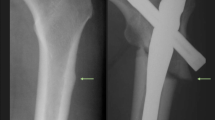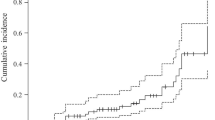Abstract
Summary
The risk factors for atypical femur fracture in patients exposed to bisphosphonates for at least 1 year were examined. Prolonged and continuous use of bisphosphonates, long-term use of glucocorticoids, and a higher body mass index were associated with increased risk of atypical femur fracture.
Introduction
The purpose of the present study is to determine whether rheumatoid arthritis (RA) and other clinical factors are associated with an increased risk of bisphosphonate (BP)-related atypical femur fracture (AFF).
Methods
A retrospective nested case-control study of patients who had taken BPs for at least 1 year was conducted. Patients with AFF were identified by reviewing surgical and radiographic records. Three controls with no history of AFFs were randomly selected and age- and sex-matched to each patient with AFFs. Cox proportional hazard models were used to analyze the independent contribution of risk factors to BP-related AFF.
Results
Among the 35,104 patients prescribed BPs for at least 1 year, 43 females (mean age, 68 years) suffered AFFs (0.12%). Patients with AFFs were exposed to BPs for a mean of 7.3 years. Patients with AFFs were exposed to BPs for longer than those without AFFs and continued treatment without a drug holiday. More patients with AFF than controls had taken glucocorticoids and disease-modifying anti-rheumatic drugs. Multivariate Cox regression analyses estimated that long-term use of glucocorticoids, prolonged exposure to BP without cessation, and every 1 kg/m2 increase in the body mass index (BMI) increased the hazard ratio for AFFs by 3.0, 5.2, and 1.2, respectively.
Conclusions
Prolonged and continuous use of BPs, long-term use of glucocorticoids, and a higher BMI increase the risk of AFFs. Switching long-term BP and glucocorticoid users to other bone-protective agents should be considered.

Similar content being viewed by others
References
Russell RG, Watts NB, Ebetino FH, Rogers MJ (2008) Mechanisms of action of bisphosphonates: similarities and differences and their potential influence on clinical efficacy. Osteoporos Int 19(6):733–759
Hochberg MC, Ross PD, Black D, Cummings SR, Genant HK, Nevitt MC, Barrett-Connor E, Musliner T, Thompson D (1999) Larger increases in bone mineral density during alendronate therapy are associated with a lower risk of new vertebral fractures in women with postmenopausal osteoporosis. Fracture Intervention Trial Research Group. Arthritis Rheum 42(6):1246–1254
Hochberg MC, Greenspan S, Wasnich RD, Miller P, Thompson DE, Ross PD (2002) Changes in bone density and turnover explain the reductions in incidence of nonvertebral fractures that occur during treatment with antiresorptive agents. J Clin Endocrinol Metab 87(4):1586–1592
Brauer CA, Coca-Perraillon M, Cutler DM, Rosen AB (2009) INcidence and mortality of hip fractures in the united states. JAMA 302(14):1573–1579
Leslie WD, O’Donnell S, Jean S et al (2009) TRends in hip fracture rates in canada. JAMA 302(8):883–889
Marx RE (2003) Pamidronate (Aredia) and zoledronate (Zometa) induced avascular necrosis of the jaws: a growing epidemic. J Oral Maxillofac Surg 61(9):1115–1117
Odvina CV, Zerwekh JE, Rao DS, Maalouf N, Gottschalk FA, Pak CY (2005) Severely suppressed bone turnover: a potential complication of alendronate therapy. J Clin Endocrinol Metab 90(3):1294–1301
Solomon DH, Mercer E, Woo SB, Avorn J, Schneeweiss S, Treister N (2013) Defining the epidemiology of bisphosphonate-associated osteonecrosis of the jaw: prior work and current challenges. Osteoporos Int 24(1):237–244
Suresh E, Pazianas M, Abrahamsen B (2014) Safety issues with bisphosphonate therapy for osteoporosis. Rheumatology (Oxford) 53(1):19–31
Pedrazzoni M, Giusti A, Girasole G, Abbate B, Verzicco I, Cervellin G (2016) Atypical femoral fractures in Italy: a retrospective analysis in a large urban emergency department during a 7-year period (2007–2013). J Bone Miner Metab. doi:10.1007/s00774-016-0790-7
Lo JC, Hui RL, Grimsrud CD, Chandra M, Neugebauer RS, Gonzalez JR, Budayr A, Lau G, Ettinger B (2016) The association of race/ethnicity and risk of atypical femur fracture among older women receiving oral bisphosphonate therapy. Bone 85:142–147
Kim SC, Kim DH, Mogun H, Eddings W, Polinski JM, Franklin JM, Solomon DH (2016) Impact of the US Food and Drug Administration’s safety-related announcements on the use of bisphosphonates after hip fracture. J Bone Miner Res 31(8):1536–1540
Park-Wyllie LY, Mamdani MM, Juurlink DN, Hawker GA, Gunraj N, Austin PC, Whelan DB, Weiler PJ, Laupacis A (2011) Bisphosphonate use and the risk of subtrochanteric or femoral shaft fractures in older women. JAMA 305(8):783–789
Koh JH, Myong JP, Jung SM, Lee J, Kwok SK, Park SH, Ju JH (2016) Atypical femoral fracture in rheumatoid arthritis patients treated with bisphosphonates: a nested case-control study. Arthritis Rheumatol 68(1):77–82
Shane E, Burr D, Abrahamsen B, Adler RA, Brown TD, Cheung AM, Cosman F, Curtis JR, Dell R, Dempster DW, Ebeling PR, Einhorn TA, Genant HK, Geusens P, Klaushofer K, Lane JM, McKiernan F, McKinney R, Ng A, Nieves J, O'Keefe R, Papapoulos S, Howe TS, van der Meulen MC, Weinstein RS, Whyte MP (2014) Atypical subtrochanteric and diaphyseal femoral fractures: second report of a task force of the American Society for Bone and Mineral Research. J Bone Miner Res 29(1):1–23
Saita Y, Ishijima M, Mogami A, Kubota M, Baba T, Kaketa T, Nagao M, Sakamoto Y, Sakai K, Kato R, Nagura N, Miyagawa K, Wada T, Liu L, Obayashi O, Shitoto K, Nozawa M, Kajihara H, Gen H, Kaneko K (2014) The fracture sites of atypical femoral fractures are associated with the weight-bearing lower limb alignment. Bone 66:105–110
Koshino T, Takeyama M, Jiang LS, Yoshida T, Saito T (2002) Underestimation of varus angulation in knees with flexion deformity. Knee 9(4):275–279
Shetty GM, Mullaji A, Bhayde S, Nha KW, Oh HK (2014) Factors contributing to inherent varus alignment of lower limb in normal Asian adults: role of tibial plateau inclination. Knee 21(2):544–548
Giusti A, Hamdy NA, Dekkers OM, Ramautar SR, Dijkstra S, Papapoulos SE (2011) Atypical fractures and bisphosphonate therapy: a cohort study of patients with femoral fracture with radiographic adjudication of fracture site and features. Bone 48(5):966–971
Schilcher J, Michaelsson K, Aspenberg P (2011) Bisphosphonate use and atypical fractures of the femoral shaft. N Engl J Med 364(18):1728–1737
Feldstein AC, Black D, Perrin N, Rosales AG, Friess D, Boardman D, Dell R, Santora A, Chandler JM, Rix MM, Orwoll E (2012) Incidence and demography of femur fractures with and without atypical features. J Bone Miner Res 27(5):977–986
O'Brien CA, Jia D, Plotkin LI, Bellido T, Powers CC, Stewart SA, Manolagas SC, Weinstein RS (2004) Glucocorticoids act directly on osteoblasts and osteocytes to induce their apoptosis and reduce bone formation and strength. Endocrinology 145(4):1835–1841
Henneicke H, Gasparini SJ, Brennan-Speranza TC, Zhou H, Seibel MJ (2014) Glucocorticoids and bone: local effects and systemic implications. Trends Endocrinol Metab 25(4):197–211
Jia D, O'Brien CA, Stewart SA, Manolagas SC, Weinstein RS (2006) Glucocorticoids act directly on osteoclasts to increase their life span and reduce bone density. Endocrinology 147(12):5592–5599
Weinstein RS (2011) Clinical practice. Glucocorticoid-induced bone disease. N Engl J Med 365(1):62–70
Grossman JM, Gordon R, Ranganath VK, Deal C, Caplan L, Chen W, Curtis JR, Furst DE, McMahon M, Patkar NM, Volkmann E, Saag KG (2010) American College of Rheumatology 2010 recommendations for the prevention and treatment of glucocorticoid-induced osteoporosis. Arthritis Care Res (Hoboken) 62(11):1515–1526
Saag KG, Emkey R, Schnitzer TJ, Brown JP, Hawkins F, Goemaere S, Thamsborg G, Liberman UA, Delmas PD, Malice MP, Czachur M, Daifotis AG (1998) Alendronate for the prevention and treatment of glucocorticoid-induced osteoporosis. Glucocorticoid-Induced Osteoporosis Intervention Study Group. N Engl J Med 339(5):292–299
Saag KG, Shane E, Boonen S, Marin F, Donley DW, Taylor KA, Dalsky GP, Marcus R (2007) Teriparatide or alendronate in glucocorticoid-induced osteoporosis. N Engl J Med 357(20):2028–2039
Teitelbaum SL, Seton MP, Saag KG (2011) Should bisphosphonates be used for long-term treatment of glucocorticoid-induced osteoporosis? Arthritis Rheum 63(2):325–328
Plotkin LI, Bivi N, Bellido T (2011) A bisphosphonate that does not affect osteoclasts prevents osteoblast and osteocyte apoptosis and the loss of bone strength induced by glucocorticoids in mice. Bone 49(1):122–127
Iwata K, Mashiba T, Hitora T, Yamagami Y, Yamamoto T (2014) A large amount of microdamages in the cortical bone around fracture site in a patient of atypical femoral fracture after long-term bisphosphonate therapy. Bone 64:183–186
Mashiba T, Turner CH, Hirano T, Forwood MR, Johnston CC, Burr DB (2001) Effects of suppressed bone turnover by bisphosphonates on microdamage accumulation and biomechanical properties in clinically relevant skeletal sites in beagles. Bone 28(5):524–531
Schilcher J, Koeppen V, Aspenberg P, Michaëlsson K (2014) Risk of atypical femoral fracture during and after bisphosphonate use. N Engl J Med 371(10):974–976
Adler RA, El-Hajj Fuleihan G, Bauer DC, Camacho PM, Clarke BL, Clines GA, Compston JE, Drake MT, Edwards BJ, Favus MJ, Greenspan SL, McKinney R Jr, Pignolo RJ, Sellmeyer DE (2016) Managing osteoporosis in patients on long-term bisphosphonate treatment: report of a Task Force of the American Society for Bone and Mineral Research. J Bone Miner Res 31(1):16–35
Emkey R, Delmas PD, Goemaere S, Liberman UA, Poubelle PE, Daifotis AG, Verbruggen N, Lombardi A, Czachur M (2003) Changes in bone mineral density following discontinuation or continuation of alendronate therapy in glucocorticoid-treated patients: a retrospective, observational study. Arthritis Rheum 48(4):1102–1108
Devogelaer JP, Goemaere S, Boonen S, Body JJ, Kaufman JM, Reginster JY, Rozenberg S, Boutsen Y (2006) Evidence-based guidelines for the prevention and treatment of glucocorticoid-induced osteoporosis: a consensus document of the Belgian Bone Club. Osteoporos Int 17(1):8–19
Sambrook PN, Kotowicz M, Nash P, Styles CB, Naganathan V, Henderson-Briffa KN, Eisman JA, Nicholson GC (2003) Prevention and treatment of glucocorticoid-induced osteoporosis: a comparison of calcitriol, vitamin D plus calcium, and alendronate plus calcium. J Bone Miner Res 18(5):919–924
Taormina DP, Marcano AI, Karia R, Egol KA, Tejwani NC (2014) Symptomatic atypical femoral fractures are related to underlying hip geometry. Bone 63:1–6
Gravallese EM, Manning C, Tsay A, Naito A, Pan C, Amento E, Goldring SR (2000) Synovial tissue in rheumatoid arthritis is a source of osteoclast differentiation factor. Arthritis Rheumatism 43(2):250–258
Napoli N, Jin J, Peters K, Wustrack R, Burch S, Chau A, Cauley J, Ensrud K, Kelly M, Black DM (2012) Are women with thicker cortices in the femoral shaft at higher risk of subtrochanteric/diaphyseal fractures? The study of osteoporotic fractures. J Clin Endocrinol Metab 97(7):2414–2422
Kim D, Sung YK, Cho SK, Han M, Kim YS (2016) Factors associated with atypical femoral fracture. Rheumatol Int 36(1):65–71
Zanchetta MB, Diehl M, Buttazzoni M, Galich A, Silveira F, Bogado CE, Zanchetta JR (2014) Assessment of bone microarchitecture in postmenopausal women on long-term bisphosphonate therapy with atypical fractures of the femur. J Bone Miner Res 29(4):999–1004
Author information
Authors and Affiliations
Corresponding author
Ethics declarations
Conflicts of interest
None.
Ethics statement
The study was approved by the Institutional Review Board of Seoul St. Mary’s Hospital (KC14RISI0555). The requirement for informed consent was waived due to the retrospective nature of the study.
Electronic supplementary material
Supplementary table 1
(DOCX 18.4 kb)
Supplementary table 2
(DOCX 17.1 kb)
Rights and permissions
About this article
Cite this article
Koh, J.H., Myong, J.P., Yoo, J. et al. Predisposing factors associated with atypical femur fracture among postmenopausal Korean women receiving bisphosphonate therapy: 8 years’ experience in a single center. Osteoporos Int 28, 3251–3259 (2017). https://doi.org/10.1007/s00198-017-4169-y
Received:
Accepted:
Published:
Issue Date:
DOI: https://doi.org/10.1007/s00198-017-4169-y




